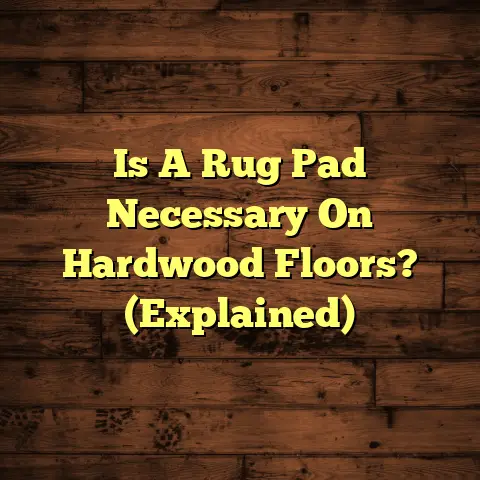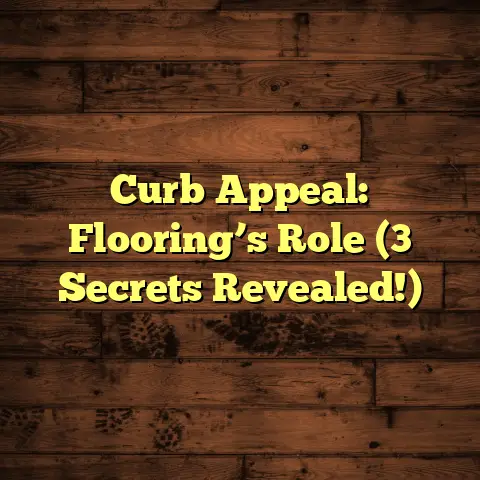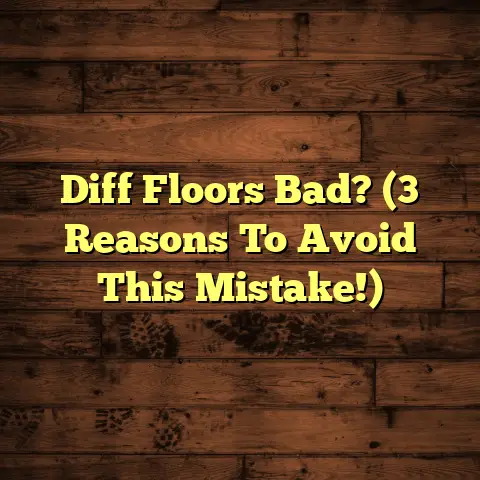Creaky Carpet Floors: Silent Fixes Now! (2 Causes)
Ugh, that creak! You know the one. The sound that seems to follow you around the house, announcing your every move. It’s your carpet floor, and it’s driving you nuts.
But hey, I get it. As a flooring contractor for over 15 years, I’ve seen (and heard!) it all. A creaky floor isn’t just annoying; it can really take away from the comfort and peace of your home.
And let’s be real, in some climates, it’s almost unavoidable. Think about it:
- Humid coastal areas: The air is thick, and moisture is constantly seeping into everything.
- Regions with extreme temperature swings: Your house is constantly expanding and contracting.
These conditions put a ton of stress on your floors.
That’s why I’m here to help. In this article, we’re going to dive into the two main culprits behind those frustrating creaks and, more importantly, give you some silent fixes to get your home back to its peaceful state.
We will do all this with easy-to-follow steps that you can do yourself.
So, grab a cup of coffee, and let’s get started!
Section 1: Understanding the Causes of Creaky Carpet Floors
Alright, before we start swinging hammers and pulling up carpets, let’s understand why your floors are singing the creaky blues.
Think of it like this: your floor is a complex system, and when one part is off, the whole thing can start to complain.
Here are the two main reasons I’ve seen cause carpet floors to creak:
- Moisture and Humidity: The sneaky culprit that can warp your floor from the inside out.
- Improper Installation: A recipe for disaster that can lead to movement and noise.
Let’s break each of these down.
Cause 1: Moisture and Humidity
Moisture is the enemy. Seriously. It’s like that persistent house guest that just won’t leave, and it can wreak havoc on your floors.
Here’s the deal:
Wood is a natural material, and it loves to absorb moisture. When humidity levels rise, especially in areas like Florida or Louisiana, your floorboards will soak up that moisture like a sponge.
As the wood expands, it rubs against other boards, nails, or the subfloor, creating those annoying creaks.
I’ve seen it firsthand. I remember one job in Miami where the humidity was so intense, you could practically see the moisture in the air. The customer’s floors were creaking like an old pirate ship!
How climate zones play a role:
- Coastal areas: High humidity year-round means constant expansion and contraction.
- Regions with heavy rainfall: Water can seep into your home through cracks in the foundation or roof.
- Basements: Often damp and prone to moisture buildup.
How moisture affects your subfloor:
The subfloor is the layer beneath your carpet, and it’s usually made of plywood or OSB (oriented strand board). If moisture gets to the subfloor, it can warp, rot, and even grow mold.
This not only creates creaks but can also lead to serious structural problems.
Here is the relative average humidity across the USA:
| City | Average Relative Humidity (%) |
|---|---|
| Phoenix, AZ | 39 |
| Miami, FL | 75 |
| Seattle, WA | 72 |
| Denver, CO | 45 |
| New York, NY | 68 |
Source: https://www.weather-us.com/en/usa/average-humidity
As you can see, the difference is significant and can play a big role in how your floor reacts.
Cause 2: Improper Installation
Okay, let’s talk about the second big offender: improper installation.
Think of it this way: your carpet is only as good as the foundation it’s built on. If the installation is shoddy, you’re setting yourself up for problems down the road.
Here are a few common installation mistakes I’ve seen:
- Inadequate nailing or stapling: If the carpet isn’t properly secured to the subfloor, it can shift and move, causing creaks.
- Using the wrong type of fasteners: Using the wrong nails or staples can cause them to loosen over time.
- Not using enough adhesive: In some cases, adhesive is needed to keep the carpet in place, especially on stairs or in high-traffic areas.
- Uneven subfloor: If the subfloor isn’t level, the carpet can flex and creak when you walk on it.
The importance of proper installation in different climates:
In regions with significant temperature changes, like the Midwest, materials expand and contract more dramatically. This means that a properly installed carpet is even more crucial to prevent movement and creaking.
I had a client in Chicago who tried to save money by installing their carpet themselves. Let’s just say it didn’t go well. The carpet was loose, the seams were visible, and it creaked like crazy.
They ended up having to hire me to redo the whole thing, which cost them even more in the long run.
Bottom line: Don’t skimp on the installation. It’s worth it to hire a professional who knows what they’re doing.
Section 2: Silent Fixes for Creaky Carpet Floors
Alright, now for the good stuff: how to fix those annoying creaks!
We’re going to tackle each cause separately and give you some practical, step-by-step solutions that you can try yourself.
Fix for Cause 1: Managing Moisture
If moisture is the culprit, the first step is to get it under control. Here’s how:
1. Assess and Manage Moisture Levels:
- Invest in a hygrometer: This handy little device measures the humidity level in your home. Aim for a relative humidity between 30% and 50%.
I personally use a ThermoPro TP65A and I recommend it to my clients.
- Check for leaks: Inspect your plumbing, roof, and foundation for any signs of leaks. Even a small leak can cause big problems over time.
- Improve ventilation: Make sure your bathrooms and kitchen have proper ventilation to remove excess moisture.
- Use a dehumidifier: This is a must-have for high-humidity areas. Place it in the room where the creaking is most noticeable.
2. Drying Out Existing Moisture:
- Use fans: Place fans in the affected area to circulate air and help dry out the carpet and subfloor.
- Rent a carpet dryer: For more serious moisture problems, you can rent a specialized carpet dryer from a local hardware store.
- Consider removing the carpet: In extreme cases, you may need to remove the carpet to allow the subfloor to dry completely.
3. Preventing Future Issues:
- Install moisture barriers: These are thin plastic sheets that are placed between the subfloor and the carpet to prevent moisture from seeping through.
- Use moisture-resistant padding: Choose a carpet padding that is designed to resist moisture and prevent mold growth.
- Regular Maintenance Checks: Keep an eye on areas prone to moisture accumulation, such as bathrooms, kitchens, and basements.
4. Tips for Homeowners:
- Clean up spills immediately: Don’t let spills sit on your carpet for long periods of time.
- Use doormats: Place doormats at all entrances to prevent dirt and moisture from being tracked into your home.
- Consider your landscaping: Make sure your landscaping is sloped away from your foundation to prevent water from pooling around your home.
Personal Story:
I once had a client in New Orleans whose floors were creaking so badly, it sounded like they were living in a haunted house. After some investigation, I discovered that their crawl space was flooded due to poor drainage.
We installed a sump pump and improved the ventilation in the crawl space, and the creaking disappeared almost immediately.
Fix for Cause 2: Installation Corrections
If improper installation is the problem, you’ll need to get your hands dirty. Here’s how to tackle it:
1. Inspect the Installation:
- Look for loose areas: Walk around the room and pay attention to areas where the carpet feels loose or moves excessively.
- Check the seams: Make sure the seams are properly sealed and not coming apart.
- Examine the edges: The edges of the carpet should be securely attached to the tack strip around the perimeter of the room.
2. Reinforce the Carpet Installation:
- Re-staple or re-nail: If you find loose areas, use a staple gun or hammer and nails to re-secure the carpet to the subfloor.
- Use carpet adhesive: For areas that are difficult to staple or nail, such as stairs or curves, use a carpet adhesive to glue the carpet in place.
- Tighten the tack strip: If the tack strip is loose, use screws to re-secure it to the subfloor.
3. Dealing with Uneven Subfloors:
- Use shims: If the subfloor is uneven, use shims to level it out before installing the carpet.
- Apply a self-leveling compound: For more serious unevenness, you can apply a self-leveling compound to create a smooth, even surface.
4. When to Hire a Professional:
- Significant installation issues: If the installation is severely flawed, it’s best to hire a professional to redo the job.
- Structural problems: If the subfloor is damaged or rotten, you’ll need to hire a contractor to repair or replace it.
- You’re not comfortable doing it yourself: If you’re not confident in your DIY skills, don’t hesitate to call a professional.
5. What to Look for in a Qualified Contractor:
- Experience: Choose a contractor with plenty of experience installing carpets.
- Reputation: Check online reviews and ask for references.
- Insurance and licensing: Make sure the contractor is properly insured and licensed.
- Warranty: Ask about the contractor’s warranty on their work.
Case Study:
I had a client who bought a new house, and the carpet in the living room was creaking like crazy. After inspecting the installation, I found that the original installers had used the wrong type of staples, and they had spaced them too far apart.
I removed the old staples and re-stapled the carpet using the correct type of staples and spacing them closer together. The creaking disappeared, and the client was thrilled.
I also recommended using a dense moisture barrier padding to prevent future problems.
Conclusion
So, there you have it! The two main causes of creaky carpet floors and some silent fixes to get your home back to its peaceful state.
Let’s recap:
- Moisture and humidity: Can cause wood to expand and contract, leading to creaks.
- Improper installation: Can lead to movement and noise.
Remember, addressing these issues promptly is crucial to enhance your home comfort and prevent further damage.
As we’ve seen, climate plays a huge role in flooring issues. Whether you’re dealing with the high humidity of the South or the temperature swings of the Midwest, understanding how your environment affects your floors is key.
Taking proactive steps to manage moisture and ensure proper installation will go a long way in maintaining a silent and comfortable home environment.
Call to Action
Now it’s your turn!
Take a walk around your home and listen for those telltale creaks. Assess your moisture levels, inspect your carpet installation, and consider the fixes we’ve discussed.
Don’t let those creaks drive you crazy any longer!
I’d love to hear about your experiences with creaky floors. Share your stories, ask questions, and let’s create a community of homeowners dedicated to improving their living spaces.
Leave a comment below or connect with me on social media. Together, we can conquer those creaks and create a more peaceful and comfortable home!





